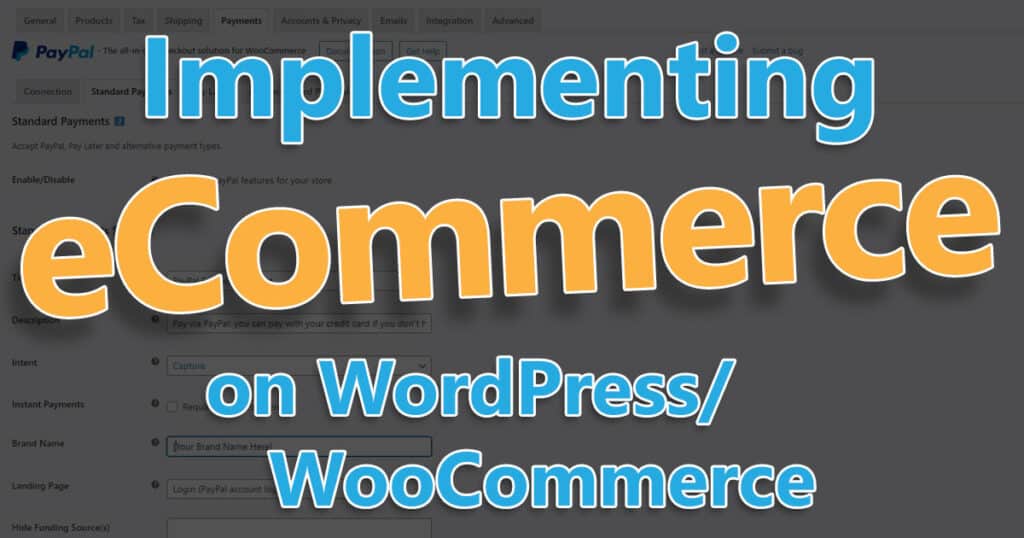
How to Setup WooCommerce: Implementing eCommerce on a WordPress Website
Looking how to setup WooCommerce on your website?
Introduction
This is a comprehensive guide to help you make decisions for eCommerce on a WordPress website using WooCommerce. This is not a technical article but rather a general information article about the necessary components in getting a website built on WordPress/WooCommerce to take payments for your products, donations or subscriptions.
Background
Having specialized in website development since 2005, we’ve found that eCommerce integration is a recurring theme in discussions with clients. The advent of eCommerce has indeed rewritten the rulebook for business operations, unlocking unprecedented potential for revenue generation. According to Kinsta, “WordPress’ market share is 43% off all websites” on the internet and WooCommerce is the premiere eCommerce platform of WordPress. In the realm of eCommerce platforms, the combination of WordPress and WooCommerce stands out as a robust choice, owing to its versatility and user-friendly experience. This comprehensive solution offers a convenient package for implementing sales, donations, and subscriptions online. However, for those lacking experience in this process, it naturally prompts a series of questions and concerns.
So what are the steps in getting started with eCommerce on WordPress?
1. What is WooCommerce and how to setup a WooCommerce store
WooCommerce is a customizable, open-source eCommerce platform built on WordPress. It facilitates the selling of products and services online. The basic gist of setting up WooCommerce involves:
- Installing and activating the WooCommerce plugin.
- It is a free plugin and it’s documentation is here: https://wordpress.org/plugins/woocommerce/
- Running the WooCommerce Setup Wizard to configure essential settings, including payment, shipping, and taxes.
- Create products to sell online.
- Integrate a payment processor to capture the transaction.
2. Website Payment Processors & Plugins
Payment processors are crucial as they manage transactions between customers and sellers and connect the funds gathered to your bank account. This is something a customer needs to do on their end. Common reputable payment processors that can be used on the WordPress/WooCommerce platform include: PayPal, Stripe, Square and Bambora.
These major payment processors have plugins for WordPress/WooCommerce that allow for “easy” and secure integration on your website. Once you have the account, they give you the necessary credentials to connect your payment processor account to the website.
Here’s a breakdown of these major payment processors compatible with WooCommerce:
a. PayPal
- Plugin: WooCommerce comes pre-installed with PayPal Standard.
- Plugin reference: https://woocommerce.com/products/woocommerce-paypal-payments/
- Fees: Typically, PayPal charges 3.49% + $0.49 per transaction – Click here for their pricing page.
- Implementation: It’s straightforward, requiring the business email associated with the PayPal account.
b. Stripe
- Plugin: WooCommerce Stripe Payment Gateway.
- Free Download: https://woocommerce.com/products/stripe/
- Fees: Stripe’s standard fees are 2.9% + $0.30 per transaction. Click here for their pricing page.
- Implementation: Requires API keys from the Stripe account, which need to be entered into the WooCommerce settings.
c. Square
- Plugin: WooCommerce Square.
- Free Download: https://woocommerce.com/products/square/
- Fees: Square’s fees are 2.9% + 30¢ per online transaction. – Click here for their pricing page.
- Implementation: Syncs with WooCommerce, allowing inventory management across all sales channels.
d. Bambora
- Plugin: WooCommerce Bambora Gateway.
- Cost: $79/Year – https://woocommerce.com/products/bambora/
- Fees: Bambora’s fees vary, so it’s advisable to consult Bambora for precise rates. Click here for more information.
- Implementation: You would need a merchant account with Bambora and API access keys for integration.
e. Amazon Pay
- Plugin: WooCommerce Amazon Pay.
- Free Download: – https://woocommerce.com/products/pay-with-amazon/
- Fees: Amazon’s fee tructure is clear for domestic processing fees, 2.9% + $0.30 per transaction. Click here for more information.
- Implementation: Requires you to connect to an Amazon Sellers Account through the WooCommerce plugin. You need to confirm the selling domain and the privacy policy URL on your website. The setup wizard will automatically transfer the necessary merchant account details into you website. Click here for a video of the connection process.
3. Donations & Necessary Plugins
For businesses looking to accept donations, several plugins can facilitate this process:
- GiveWP: This is a top-rated plugin specifically designed for accepting donations. It offers a range of customization options and supports various payment gateways. GiveWP website: https://givewp.com/
- Charitable: It’s a powerful, extendable, and user-friendly donation plugin. Charitable website: https://www.wpcharitable.com/
- Donation For WooCommerce: Donation for WooCommerce is a versatile and powerful extension, designed to facilitate the creation and management of fundraising campaigns, offering features like recurring donations, progress goals, customizable donation amounts, and round-up donations, all aimed at providing a seamless and user-friendly experience for collecting charitable donations on WooCommerce websites. Plugin link here: https://woocommerce.com/products/donation-product-for-woocommerce/
4. Subscriptions
Subscriptions can generate consistent revenue by offering products or services on a recurring basis. WooCommerce Subscriptions is a plugin that manages and sets up recurring payments for the products and services offered.
Link to Woo Subscriptions: https://woocommerce.com/products/woocommerce-subscriptions/
5. General Selling Online Information

- Product Information: Clear, concise, and informative product descriptions help draw and retain traffic on your website while building confidence in potential customers to purchase.
- Quality Photos: Most modern cell phones will have a good enough camera for this. Keep in mind light is what you are capturing with a camera so good lighting is a critical piece of this. there is an old cliché that says, “a picture is worth a thousand words” and we believe a good photograph speaks the language of sales!
- Customer Service: Accessible and responsive customer service can significantly impact the customer’s shopping experience.
- Security: Employing SSL certificates ensures secure data transactions between servers and browsers.
- SEO: Optimize the website for search engines to enhance visibility and traffic.
- Mobile Responsiveness: Ensure that the website is optimized for mobile devices to capture the mobile user market which, nowadays, is likely to be more than half of a typical website’s traffic.
- User Experience: A well-designed, user-friendly interface encourages customer interaction and sales.
6. Addressing Taxes: Using TaxJar Plugin and Service
Handling taxes is a crucial yet complex component in setting up an eCommerce platform. It involves numerous considerations, including compliance with different tax laws, applying correct tax rates, and managing tax reporting accurately. To streamline this intricate process, integrating a reliable tax management plugin like TaxJar can be extremely beneficial.
TaxJar Plugin and Service:
TaxJar is a renowned service in the realm of eCommerce, designed to simplify the administration of sales tax. It automates the calculation, reporting, and filing of sales tax, helping businesses stay compliant with varying tax laws and jurisdictions.
Key Features:
- Automatic Sales Tax Calculation: TaxJar automatically calculates sales tax in real-time for every purchase, considering the buyer’s shipping address, ensuring accuracy.
- Multi-State Support: For businesses operating in multiple states, TaxJar manages different tax rates and laws seamlessly, addressing the complexities of multi-state sales tax.
- Tax Reporting and Filing: TaxJar offers detailed reports and facilitates smooth filing of sales tax returns, aiding in keeping accurate records and meeting deadlines.
- Tax Categories Management: It distinguishes between different tax categories to apply the correct tax rates, accommodating varied product types and services.
Implementation:
Implementing TaxJar involves installing and configuring the TaxJar for WooCommerce plugin. The process requires the API token from your TaxJar account, which needs to be entered into the WooCommerce settings. Click here to view the documentation for the TaxJar for WooCommerce plugin.
Why Consider TaxJar?
The use of TaxJar can significantly reduce the manual effort and time invested in managing sales taxes, allowing businesses to focus more on their core operations. By ensuring accurate tax calculations and seamless compliance with tax laws, it minimizes the risks of errors and penalties, providing peace of mind to business owners.
Visit TaxJar’s website for more information: https://www.taxjar.com/
TaxJar Summary:
Navigating the landscape of taxes while running an eCommerce business can be daunting. Incorporating a reliable and efficient tax management plugin like TaxJar can be a game-changer. By automating various tax-related tasks and ensuring compliance, it not only enhances operational efficiency but also contributes to the overall success of the business in the eCommerce domain.
Remember, integrating proper tax management is not just about compliance; it’s about creating a seamless and transparent shopping experience for your customers, building trust and credibility in your brand.
Selling Online with WooCommerce – Final Thoughts
Implementing eCommerce on a WordPress website using WooCommerce is a meticulous process involving strategic planning and execution. Choosing the appropriate payment processor and integrating it properly is pivotal for smooth transactions. Donations and subscription models can be incorporated to diversify the revenue stream and fulfill varied business objectives.
Considering the wide array of available options, understanding individual business needs is crucial to selecting the right plugins and features. By ensuring a seamless, secure, and user-friendly experience, businesses can leverage the immense potential of eCommerce to drive growth and success.
When it comes to realizing your eCommerce vision, a professional web development company can assist in navigating through the complexities of setting up and optimizing your WooCommerce platform, allowing you to focus on what you do best—running your business.
Disclaimer
For more articles from vPaulTech, click here.
